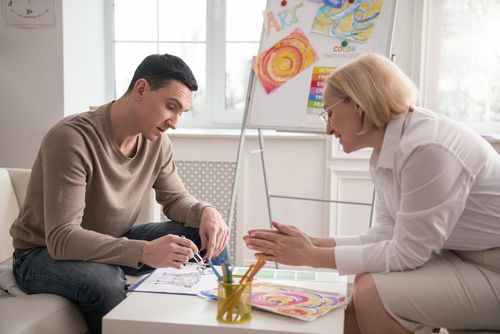What is Art Therapy?
Art therapy is a creative approach to addressing mental and emotional challenges that involves art making and counselling. It helps a person communicate what's holding them back from achieving the kind of life they want through sketching, painting, photography or other forms of art media. Art therapy can combat anxiety, depression, trauma and lead to self-awareness and a higher self-esteem.

Why Study Art Therapy?
Studying art therapy provides you with the skills and tools to empower your clients to deal with negative thoughts, ideas, beliefs and emotions that stem from painful experiences in their lives. Unlike with traditional forms of talk therapy where you just sit with the client, digging into their past, art therapy allows you to immerse them into the healing powers of different colours, shapes and patterns using an array of art materials.
Art making is a therapeutic process as it's a subtle yet profound way of communicating one's innermost feelings no words can describe. As a certified art therapist, you'll be able to release others from deeply-rooted emotional issues before these evolve and manifest as symptoms of a physical health condition.
What Does it Take to Study Art Therapy or Become an Art Therapist?
Having a compassionate and empathetic heart is more important than an artistic hand if you're looking to pursue a career as an art therapist. You must have good listening skills, a friendly demeanour and the ability to establish a good rapport with other people.
As a student of art therapy, you must hone your observation skills because in your profession, you won't be critiquing the artwork of your clients but analysing the manner in which they did it to understand the root of their problem. You will be looking at their choice of art materials, colours, shapes, etc. There's a method of doing this, which you can easily learn and master by enrolling in an accredited art therapy school.
What are the Differences Between Studying the Course Offline and Online?
Whether you're working towards a diploma or a bachelor's degree in art therapy, you can obtain your qualification on-campus or online. It's important to choose a learning platform that you're comfortable with because it will play a pivotal role in your success.
While studying in a traditional classroom setting on-campus allows you to interact with your teachers and classmates on a daily basis, you have to stick to a stringent schedule regardless of your circumstances. Distance education gives you more flexibility to balance your study time with your other commitments, especially if you have a nine-to-five job or take care of the household during the day.
Looking at the financial aspect, taking an online art therapy course makes total sense as it costs less than going to and from school every day. You'll be able to save on petrol, parking fees or bus fares, not to mention miscellaneous fees. Then again, choosing between studying online or on-campus boils down to the kind of lifestyle that you have. If the social factor weighs more, then you should consider the latter. If you want to study at your own pace and interact with students and professors of art therapy across Australia, then online learning is the way to go.
How to Choose a School or Course in Art Therapy
When scouting for an online course provider for art therapy, see to it that you check the background of the school. It's important that its faculty members are not only experienced in the field but also have the heart to heal others. Also, if you're currently practising another modality, it would be best to ask the school you're eyeing how you can incorporate your art qualification into your practice.
You also want a course provider whose offerings align with your education and career goals. Check out the list of qualified art therapy schools at the top of this page to find what you're looking for. Take the time to compare their curriculum, course fees and delivery methods. You can learn more about the art therapy programs of each institution by contacting them directly and speaking with a course advisor.






